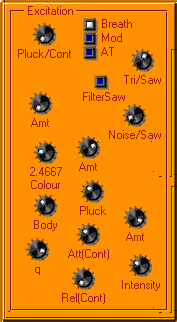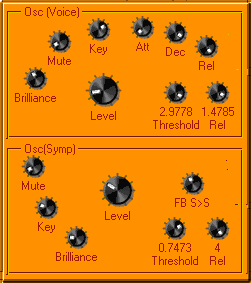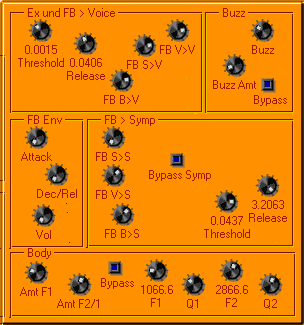BYTES
home
vst
sampling
shop
contact
newsletter
press
room
stuff
A Virtual String Instrument based on the Karplus Strong
Algorithm.
| SoBy_KS_Symp7.zip |
CONTENTS:
- Overview
- Description of modules and controllers
- Version History
OVERVIEW:
An exitation signal is triggered by a note on event or a continous controller. This Signal is fed into a Karplus-Strong oscillator. The outcome is then filtered to simulate a resonating instrument body. Part of the original waveguide signal and of the filtered signal is fed into a system of 12 sympathetic strings that is simulated by a cluster of Karplus Strong oscillators.
The Synth supports alternative tunings for Midi Note input. These are accessible from a seperate Panel. The Sympathetic Strings can also be retuned.
The Modules:
EXCITATION:
The 'Pluck' is created here as a mix of filtered noise and an
(optionally filtered) saw/triangle signal.
|
 |
OSC (Voice):
Defines the characteristics of the virtual string:
- [Mute],[Key] - dampens the sound.
- [brilliance] - changes the sound from Nylon to Steel (or maybe from pure Nylon to Brasswound nylon ;)
- [Threshold],[Release] - Controls for the Limiter
- [Att],[Dec],[Rel] - Envelope controls
- [Voice Level] - Output level (This has no influence on the voice amount that is fed into the Voice or Symp oscillators)

OSC(Symp):
Controls for the Sympathetic cluster.
- [Tune] - The cluster is tuned in a diatonic scale in the key of C major. Use the Tune knob to transpose the sympathetic strings.
- [Mute],[Key] - dampens the sound.
- [brilliance] - changes the sound from Nylon to Steel (or maybe from pure Nylon to Brasswound nylon ;)
- [Threshold],[Release] - Controls for the Limiter
- [Symp Level] - Output level (This has no influence on the symp amount that is fed into the Voice or Symp oscillators)
- [FB S>S] - will feed each Symp string output back into itself.
EX AND FB > VOICE:
Here the Excitation is mixed with a number of Feedback signals. Sources are: The voice output, the sympathetic cluster, and the final filtered output (body). This composed signal is then compressed to minimize the risk of feedback resonance.
- [FB B>V] - The filtered 'Body' Signal contains the whole mix
- [FB S>V] - The input from the sympathetic cluster.
- [FB V>V] - The Amount of the Voice Signal
- [Threshold],[Release] - Controls for the Limiter

FB > SYMP:
- [FB S>S] - The output of the whole cluster is fed back into all the oscillators.
- [FB V>S] - The Amount of the Voice Signal.
- [FB B>S] - The filtered 'Body' Signal contains the whole mix
- [Threshold],[Release] - Controls for the Limiter
BUZZ:
Some edge can be added to the Voice output.
- [Buzz] - A simple clipper
- [Buzz Amt] - Mix of buzzed and unbuzzed signal
- [bypass] - switches the buzzer of
FB ENV:
The Feedback envelope works on the Voice Signal that is fed back into itself and into the Symp Cluster.
- [Att],[Dec/Rel],[Vol] - the Vol parameter is fully active when Pluck is selected. Vol rises to 1 as the continous (bowed) excitation is faded in.
Body:
Two cascaded Filters (2 pole LP) are used to simulate an instrument body.
- [F1],[Q1],[F2],[Q2] - Filter controls
- [Amt F1] - Mixes the output of Filter 1 with the unfiltered signal. The crossfade output is then fed into Filter2
- [Amt F1/2] - Mix of the Filter 2 output with the unfiltered signal.
History:
KS Symp4:
- First release
KS Symp5:
- fixed some bugs
- Replaced Compressors with new CPU friendly Limiter modules
- Introduced Limiters as Feedback Protection also at the output of the Voice oscillator and of each Sympathetic oscillator.
- Panel restructured
- reworked the Presets
- Continous controller selection Mod/Breath/Aftertouch introduced in the excitation module (for bowed sounds)
KS Symp7:
- Restructured the Excitation Module
- Replaced the Bow/Pluck switch with a control. This enables fades between the two modes.
- Added a Tuning table to the Sympathetic Cluster.
- Added a Tuning Table to the Midi Note Input